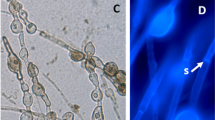Summary
A study of the colonization of barley root surfaces by sterile dark fungi is described in which the root washing-segment plating technique and direct observation were employed to study the pattern of root colonization. Data are presented showing sterile dark fungi to be rapid colonizers of young roots and to persist on the roots with increasing root age.
Similar content being viewed by others
References
Burges, N. A. and Nicholas, D. P., Use of soil sections in studying the amount of fungal hyphae in soil. Soil Sci.92, 25–29 (1961).
Ebben, M. H. and Williams, P. H., Brown rot of tomatoes. I. The associated fungal flora. Ann. Applied Biol.44, 425–436 (1956).
Glynne, M. D., Fungal invasions of the roots of healthy wheat plants. Trans. Brit. Mycol. Soc.23, 210 (1939).
Harley, J. L., Recent progress in the study of endotrophic mycorrhiza. New Phytol.49, 213–247 (1950).
Harley, J. L. and Waid, J. S., A method of studying active mycelia on roots and other surfaces in soil. Trans. Brit. Mycol. Soc.38, 104–118 (1955).
Katznelson, H. and Richardson, L. T., The microflora of the rhizosphere of tomato plants in relation to soil sterilization. Can. J. Research (C),21, 249–255 (1943).
Parkinson, D. and Clarke, J. H., Fungi associated with the seedling roots ofAllium porrum L. Plant and Soil13, 384–390 (1961).
Parkinson, D. and Williams, S. T., A method of isolating fungi from soil micro-habitats. Plant and Soil13, 347–355 (1961).
Parkinson, D., Taylor, G. S. and Pearson, R., Studies on fungi in the root region. I. The development of fungi on root surfaces of crop plants. Plant and Soil19, 332–349 (1963).
Peterson, E. A., Observations on fungi associated with plant roots. Can. J. Microbiol.4, 257–265 (1958).
Richardson, J. K. and Berkeley, G. H., Basal rot of tomatoes. Phytopathology34, 615–621 (1944).
Robertson, N. F., Studies on the mycorrhiza ofPinus sylvestris. I. The pattern of development of mycorrhizal roots and its significance for experimental studies. New Phytol.53, 253–283 (1975).
Ross, D. J., Physiological studies of some common fungi from grassland soils. New Zealand J. Sci.3, 219–257 (1960).
Rossi, G. M. and Riccardo, S., L'esame microscopie e bacteriologica diretto del terreno agrario. Nuovi Ann. Minist. Agr.7, 457–470 (1927).
Sewell, G. W. F., Studies of fungi in aCalluna — heathland soil. I. Vertical distribution in soil and on root surfaces. Trans. Brit. Mycol. Soc.42, 343–353 (1959).
Sewell, G. W. F., Ibid.. Trans. Brit. Mycol. Soc.42, 354–369 (1959).
Stenton, H., The soil fungi of Wicken Fen. Trans Brit. Mycol. Soc.36, 304–314 (1953).
Taylor, G. S. and Parkinson, D., Studies on fungi in the root region. IV. Fungi associated with roots ofPhaseolus vulgaris L. Plant and Soil22, 1–20 (1965).
Thornton, R. H., The screened immersion plate: a method of isolating soil micro-organisms. Research 5, (1952).
Thornton, R. H.Rhizoctonia in natural grassland soils. Nature (Lond.)177, 230–231 (1956).
Thornton, R. H., Biological studies of some tussock-grassland soils. II. Fungi. New Zealand J. Agr. Research1, 922–938 (1958).
Waid, J. S., Root dissection: a method of studying the distribution of active mycelia within root tissues. Nature (Lond.)178, 1477–1478 (1956).
Waid, J. S., Distribution of fungi within decomposing tissues of rye-grass roots. Trans. Brit. Mycol. Soc.40, 391–406 (1957).
Warcup, J. H., The soil plate method for isolation of fungi from soil. Nature (Lond.),166, 117 (1950).
Warcup, J. H., Isolation of fungi from hyphae present in soil. Nature (Lond.)175, 953–954 (1955).
Warcup, J. H., Studies on the occurrence and activity of fungi in a wheat-field soil. Trans. Brit. Mycol. Soc.40, 237–262 (1957).
Warcup, J. H., Studies on Basidiomycetes in soil. Trans. Brit. Mycol. Soc.42, 45–52 (1959).
Author information
Authors and Affiliations
Rights and permissions
About this article
Cite this article
Parkinson, D., Pearson, R. Studies on fungi in the root region. Plant Soil 27, 113–119 (1967). https://doi.org/10.1007/BF01373982
Received:
Issue Date:
DOI: https://doi.org/10.1007/BF01373982



